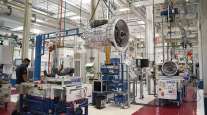Service Industries Expand at Slowest Pace in a Year

Service industries expanded in May at the slowest pace in 13 months as orders eased, signaling tempered improvement in the biggest part of the U.S. economy.
The Institute for Supply Management’s nonmanufacturing index, which includes an array of industries from real estate to dining, declined to 55.7 from April’s 57.8, the Tempe, Arizona-based group said June 3. Readings above 50 signal expansion, and the May gauge was weaker than the 57 median forecast in a Bloomberg News survey.
Limited growth in orders reflects an American consumer who has been saving the extra cash from low gasoline prices and rising employment rather than spending it. Stronger household demand would help invigorate growth at service providers that make up almost 90% of the economy.
“There’s hardly any positive impetus right now in consumer spending, which is a large portion of the service sector,” Millan Mulraine, deputy head of U.S. research and strategy at TD Securities USA in New York, said before the report. Still, economic growth will “rebound from last quarter.”
Estimates in the Bloomberg survey of 79 economists ranged from 55 to 60. The group’s nonmanufacturing survey covers a broad base of service industries that also include utilities, retailing and health care, in addition to construction and agriculture.
ISM’s new orders gauge fell to 57.9 in May from 59.2 a month earlier. The index of backlogs slumped by 6 points to 48.5, the weakest reading since December 2013.
An index of employment in service industries cooled to 55.3 in May from 56.7.
The business activity measure dropped to 59.5 from the prior month’s 61.6. The figure parallels ISM’s factory production gauge, which also cooled last month.
The group said June 1 that its manufacturing index expanded in May, with orders growing at the strongest pace in five months, as the economy began to emerge from a first-quarter downturn. The pickup in bookings and strongest reading for order backlogs since November point to production gains that probably will help gross domestic product bounce back after shrinking in the first quarter.
The dollar’s advance since mid-2014 and the global drop in oil prices have reduced exports and business investment, exacting a bigger toll on manufacturing than service producers.
The appreciating greenback curtailed overseas shipments in the first quarter, causing the trade gap to subtract the most from GDP in 30 years. The deficit cut 1.9 percentage points from the economy, the most since 1985.
Merchandise flows started returning to normal in April. The trade deficit narrowed more than forecast during the month, shrinking by 19.2% to $40.9 billion, as imports receded, Commerce Department figures showed.
GDP, the volume of all goods and services produced, shrank at a 0.7% annualized rate from January through March, revised from a previously reported 0.2% gain, according to Commerce Department figures issued May 29 in Washington. It was the weakest reading since frigid winter temperatures derailed growth at the start of 2014.
Sustained improvement in hiring and household spending, which accounts for almost 70% of the economy, are needed to ensure growth rebounds as Federal Reserve officials project.
Federal Reserve Governor Lael Brainard said a recent run of weak data casts doubt on the strength of the economy. In a speech to the Center for Strategic and International Studies in Washington, Brainard suggested she’s open to a delay in the Fed’s timetable for an interest-rate increase this year.
“There is value to watchful waiting while additional data help clarify the economy’s underlying momentum,” Brainard said June 2. “If continued labor market strengthening is confirmed and inflation readings continue to improve, liftoff could come before the end of the year.”
Consumer spending unexpectedly stalled in April as the saving rate grew. An unchanged reading in purchases followed a 0.5% gain the prior month that was larger than previously estimated, Commerce Department figures showed June 1.
May auto sales figures indicate consumers aren’t retrenching totally. Most automakers beat estimates for May light-vehicle sales, with General Motors Co.’s results the best for the month since 2007 and Fiat Chrysler’s the highest in a decade. The annualized rate of U.S. sales jumped to 17.7 million, the strongest since July 2005, according to Ward’s Automotive Group.
Fiat Chrysler’s North American unit delivered 202,227 vehicles, a 2.6% gain from May 2014.
“Our Jeep brand continues to set records with its best monthly sales ever in May,” Reid Bigland, Fiat Chrysler’s head of U.S. sales, said in a statement. May was the first time Fiat Chrysler topped 200,000 in monthly sales since March 2007.


